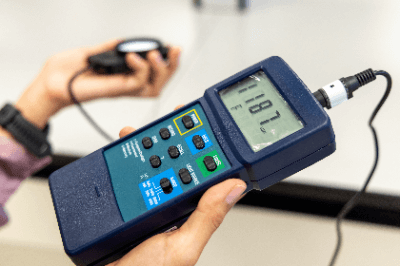What Is a Digital Light Meter?
 A digital light meter is a measuring instrument that measures and quantifies the brightness of light as perceived by human vision.
A digital light meter is a measuring instrument that measures and quantifies the brightness of light as perceived by human vision.
It measures illuminance in lux (Lx: lux0), a unit of illuminance in the International System of Units (SI). A digital light meter is characterized by its display panel, which allows the continuously changing illuminance to be handled as step-by-step numerical data.
On the other hand, analog-type illuminance meters are equipped with a scale plate that allows recognition of continuously changing illuminance by a needle or other device that indicates continuous changes.
Uses of Digital Light Meters
A digital light meter is used to measure the brightness of light. Since the displayed value is relatively easy to read, they are easy to handle for beginners in measurement.
There are two types of digital light meter: an integrated type in which the sensor and display are connected, and a separate type in which the sensor and display are separated by a cable, etc. The integrated type is suitable when the illuminance is to be checked simply outdoors or when the illuminance is to be measured in an artificial weather chamber for experiments or tests.
Many of the integrated types are portable and easy to carry. They range from inexpensive ones for easy measurement to expensive ones for special environments or with data logger functions. Separate types can select and change the light-receiving part to match the type of light source and measurement environment, and some can measure multiple points simultaneously and record data.
Principle of Digital Light Meters
The light receiving part of illuminance meters often incorporates a photoresistor, whose electrical resistance is reduced by light irradiation, or a photodiode, which generates a current or voltage. Using these electronic components, light intensity can be analog-converted into current or voltage values, thus enabling the recognition of illuminance.
Furthermore, an A/D converter (analog-to-digital converter) is incorporated into the circuit to digitally convert the analog-converted illuminance value, which is then quantified on a display board. An optical filter is placed over the light-receiving part to match the light intensity to the sensitivity of the eye, and a calibration curve is drawn using a filament-type bulb as a standard light source to calibrate the digital light meter’s value.
Therefore, the illuminance of fluorescent lamps, LED lights, sunlight in different weather conditions, etc., which have different wavelength characteristics from the standard bulb, may result in different illuminance when measured using illuminance meters with different structures and components. When comparing illuminance data after acquisition, it is necessary to make a special effort to use a digital light meter with the same model number that is composed of the same structure and components.
How to Select a Digital Light Meter
When selecting a digital light meter, the following points should be considered:
1. Measurement Range
The most important factor in selecting a digital light meter is whether it can handle the range of illuminance you want to measure. If accuracy is important in addition to range, you should select an illuminance meter that can measure with high accuracy.
2. Units and Indications
It is necessary to confirm that the illuminance unit can be displayed in accordance with the standard of the country or industry, where the illuminance meter will be used. In addition, a clear and easy-to-read digital display will help prevent misreading.
3. Operability and Ease of Use
The key is an illuminance meter that has an intuitive operation with an easy-to-understand button layout and menu structure. We recommend that the meter have an easy-to-use interface and that it is easy to set up and read data.
4. Response Time
This is the time required to detect and display changes in illuminance quickly, so it is important to select an illuminance meter with a short response time when used in an environment with instantaneous fluctuations or high-speed operation. Alerts and rapid response may be required if necessary.
5. Power Supply and Battery Life
A digital light meter requires a power source, and it is important to check the status of power options, such as battery-powered or AC adapter-compatible, depending on the environment in which it will be used. It is also important to select products with long battery life and short recharging times.